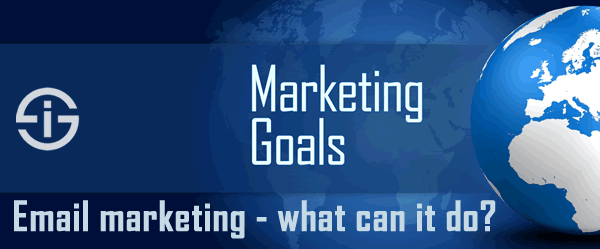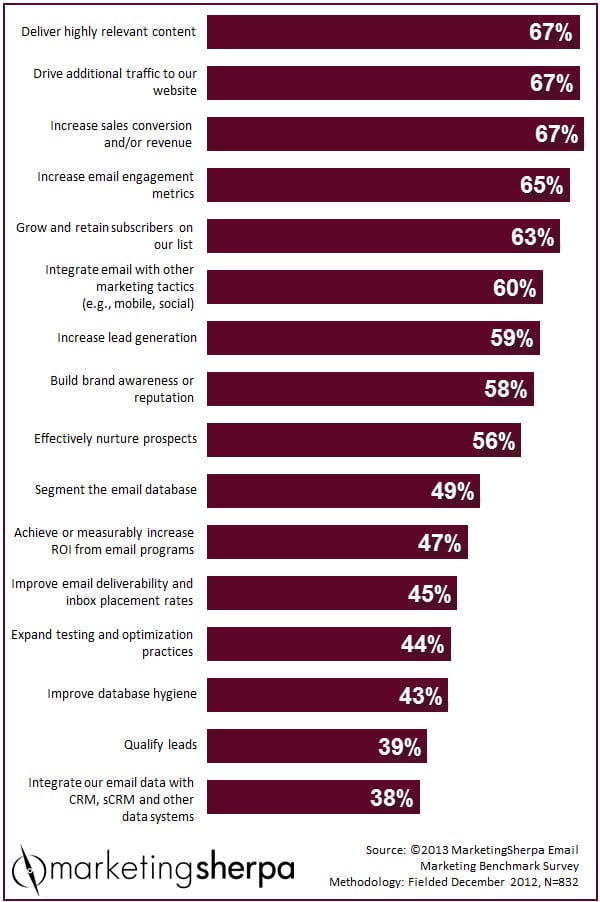Email is a channel and plays a role in many customer interactions, also beyond marketing (email is still the most used digital channel for customers seeking service, for instance). As a channel and as a marketing discipline, email can serve virtually all digital marketing goals.
So, asking what marketing goals email marketing can serve is probably not the best question. The better question to ask is what you can’t do with email marketing from a goal perspective. The answer: there is not a lot you can’t do with it. Email marketing can be used for several marketing purposes, from down-to-earth sales goals and branding to customer retention and loyalty. In practice, an integrated and customer-centric email marketing program will serve several goals at once, while specific programs focus on one core goal (such as a loyalty program, acquisition, you name it). Another smart question to answer is where email fits in the bigger picture of the goals and preferences of your “audiences”.

Nevertheless, below is a list of marketing goals you can serve using email. However, first we need to remind you of a few things.
Some considerations when using email marketing for specific goals
Email marketing is not an island.
The days that email marketers work in silos, as many others do are over. Every marketing goal is served using a smart mix of channels with the customer in mind.
Email marketing across the organization.
In larger organizations, often several marketing teams have their own isolated email programs. Here as well, it’s key to connect the dots.
Each marketing goal revolves around a customer goal.
Instead of asking what marketing goals can be served using email, start looking at the goals, behavior and preferences of customers first. Your goals should be aligned with theirs, where the true value creation happens.
Marketing goals should be connected.
Remember that each channel is used by different people for different reasons and that customers don’t think in terms of your goals. Even if you don’t use email marketing for branding reasons, each email has a branding effect and contributes to the overall end-to-end customer experience.
Email is a communication channel.
Although email marketing is a marketing technique requiring a specific skillset, email is a channel that gets used across virtually all communications. Think beyond just campaigns and newsletters. Email is also important in content marketing, lead nurturing, customer service, well, everything really. Just think about the many flows in a demand generation and lead nurturing or marketing automation context.
Email marketing programs and campaigns.
Far too many organizations still work in an ad hoc way when it boils down to achieving their goals. A customer-centric and integrated marketing program uses campaigns in a contextual and channel-overlapping way whereby each campaign aims to leverage the impact of previous campaigns. We even still see far too many organizations that develop ad hoc campaigns within one channel or tactic such as email marketing. A big no no.
Email marketing goals
There are more things to consider (again: focus on the customer and think beyond the channel and any silo whatsoever, also regarding data, measurement, etc.) but, now that we tackled this, here are some “general” goals email marketing can serve (again, de facto overlapping each other).
The chart below from MarketingSherpa also shows you some of the main reasons marketers use email and what goals they hope to achieve using email marketing.

Building traffic
Recurrently sent email newsletters are great ways to drive traffic to the websites, blogs or whatever piece of content or online property of the newsletter’s sender. Traffic can be a goal as such for people who live from traffic. In reality, most of us don’t. So, as such traffic is pretty meaningless isn’t followed by action and interaction, even if it’s via another channel.
The old saying that ‘the money is in the list’ still can make lots of sense if you treat folks in the list well. The more traffic you want, the more relevant, tailored and personalized the emails typically have to be. Offer email as a channel with a clear value proposition (“why would people really want to sign up for my emails?”) and where possible strong emotional trigger. If you want to have traffic, you want to offer value.
The art of acquiring
Whether you organize an event, look for employees, reach out to people, hoping they download a whitepaper, want to turn website visitors into subscribers of a newsletter or want to build a “list” of people for whatever acquisition reason: email marketing allows you to build a permission-based database of consumers (there are no others) that are interested in your specific proposition.
This can be done by sending out emails on your own opt-in database or by sending out messages in email newsletters of third parties that target your focus group in order to get them in your list. And of course by offering multiple subscription possibilities. Again: the value proposition (and delivering upon that promise) is key, as are smart customer-oriented flows in function of the customer. By the way: never forget that lists and databases, segments of lists etc. consist of people of flesh and blood, not just addresses behind a screen. These people also get older, change and have other preferences over time. Make sure you measure closely, offer preference centers, and have different ways of gauging, asking, analyzing and – increasingly – predicting their interests.
Sales purposes
Email marketing isn’t always about integration in function of marketing goals, customer goals, connected flows, demand generation, lead nurturing etc. It isn’t always about relevant content in a non-promotional way either.
There are millions of people out there (such as my wife) who are very happy to receive – ideally somewhat personalized – deals and promotions, directly and indirectly driving sales. And it’s not just the case for businesses with online sales possibilities. Email can drive sales in an offline environment very well, thank you very much.
Customer retention and loyalty
Regularly sending out a newsletter to inform customers about your company, products or services, is ideal for customer retention purposes. Furthermore email can be used as a medium to offer added value services (valuable information, promotions,…) to your existing customers and partners.
There are different techniques to use email marketing as a customer retention tool but also loyalty programs and even ambassadorship programs can be achieved using a smart use of email. It’s key to stay as close to the customer as possible in and beyond transactional processes and across the customer life cycle. Examples of such programs can include: special rebates or loyalty programs for specific customer segments (requiring a single view), follow-up actions, or instance, asking for feedback after a booked holiday, etc. Too much automation can work counterproductive here and an integrated community approach can work better.
Demand generation and lead nurturing
More advanced email marketing platforms and marketing automation software (connected with other systems or offered as big marketing suites as we often see), offer marketers a way to use email (triggered, flows, etc.) and email marketing to move away from a campaign-centric view and build smart demand generation and lead nurturing programs
In such programs the loops between marketing and sales can get closed if both are well aligned, customer preferences and behavior are taken into account and the focus is on the sweet spots where customer value meets businesses value. This goes hand in hand with, among others, lead scoring possibilities, data-driven marketing automation/personalization, progressive profiling, real-time interaction possibilities and the inevitable integrated approach. Content is essential here.
Read more about the role and use of content in email and marketing automation.
Branding and perception
Can email be used for branding purposes? Of course. Just as is the case with that other relatively more direct response marketing tactic, search engine marketing. Everything you do as a brand has a brand impact anyway and it does affect the customer experience.
However, you can also perfectly use email marketing for pure branding reasons, mostly integrated within a broader context. The various brand attributes such as brand awareness, loyalty and purchase intent, can all be served by email. When companies use email to start a personal communication with their prospects, to keep customers posted about their orders or to inform those customers about what is going on at the company, they send clear brand messages to their email contacts. It’s important to realize that, even if your goal is not branding. Again: you are interacting with people of flesh and blood via a touchpoint that matters a lot. Therefore, email marketing deserves the proper attention, planning, content and much more, as each person on your list deserves that attention.
Remember that the end-to-end customer experience is shaped by all touchpoints and interactions. Or in other words: don’t do email marketing if, as is still too often the case, it’s an afterthought or a last-minute thing you have to do quickly before ending the week (“darn, I still have to send my newsletter, who has anything to share?”).
Content distribution
Sign of the times and of the popularity of content marketing. Content distribution is not a marketing goal but do read on.
While we used to look at email marketing and other digital marketing tactics (including search and simply building websites) in the early days of the Web from a customer/visitor perspective whereby we needed content to fulfil our goals and make the customer journey and customer experience online a pleasant and relevant one (even if over a decade later many still struggle to do this), today we look at email as a distribution channel of content as well. This is not without dangers, especially if we move from channel-centricity to content-centricity as explained and illustrated here. In order to find content, it needs to be found, seen and sent in the first place. That requires a mix of inbound and outbound tactics although the distinction between inbound and outbound always has been an artificial one. Integrated and customer-centric marketing is non-bound as the customer decides.
Research keeps showing that newsletters (and email marketing) are the most used and efficient channels/tactics in content marketing. The other way around, email marketing requires some content planning too. As email is key in content marketing (and in the nurturing and progressive profiling stages we typically see in marketing automation), it can serve all marketing goals you can fulfil with content marketing as well. And that’s virtually anything too. This probably shows best how it’s key to look at the bigger (digital) marketing picture. Content marketing needs email and email marketing needs content, in function of the customer in the broadest sense.
More marketing goals
This list of marketing goals that can be served using email marketing is not exhaustive. A few other examples:
- Email marketing can be used to improve the impact of marketing efforts across other channels.
- Email marketing works well to improve the quality of customer databases (to optimize through segmentation, enrichment and testing, among others).
- Insights from email marketing can help improve and even change the overall marketing strategy.
- Etc.
Images purchased under license from Shutterstock

